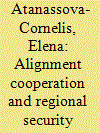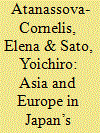|
|
|
Sort Order |
|
|
|
Items / Page
|
|
|
|
|
|
|
| Srl | Item |
| 1 |
ID:
172381


|
|
|
|
|
| Summary/Abstract |
Although the US-led system of formal alliances remains the main pillar of the regional security architecture in Asia, alignment cooperation – centred on the Indo-Pacific maritime conceptualisation of the region – has been on the rise. This includes informal bilateral and minilateral agreements for security collaboration between regional and extra-regional US treaty allies or close security partners, notably Japan, Australia, India, the United Kingdom and France. While the various alignments complement and address the deficiencies of the formal US-led alliances, the functional and informal characteristics of alignments allow countries to pursue security cooperation both in conjunction with the United States and independently of it. This leads to a more fluid security architecture that increasingly reflects the diversity of emerging regional ‘architects’, among which Japan is assuming a leading role, as much as the region’s array of new security challenges.
|
|
|
|
|
|
|
|
|
|
|
|
|
|
|
|
| 2 |
ID:
187213


|
|
|
|
|
| Summary/Abstract |
This article examines Japan’s security alignments with key Asian and European partners, notably Australia, India, the UK, France and the EU itself. The articles explores Tokyo’s strategic expectations with regard to each of the five partnerships, as well as probing the likely future evolution of these alignments by providing a comparative perspective. Japan’s alignments with Australia and India conform with and supplement the US-Japan alliance, addressing Japan’s primary geostrategic concerns in the Asia-Pacific and the Indian Ocean region. Tokyo’s security partnerships with the European partners, and the EU, are more recent and not rooted in any US-led alliance in Asia. The degree of traditional kinetic military power these European players can bring to Asia is very limited. However, the pace with which Japan’s new European alignments are quickly moving beyond the non-traditional security areas to encompass more traditional defence and military-security fields attests to their potential of evolving in the future into mechanisms able to perform a broad range of security functions in response to complex security threats. The boundaries between these two categories of partnerships are likely to be further blurred, providing Japan with various mechanisms at different levels to shape and influence the regional and global security environment.
|
|
|
|
|
|
|
|
|
|
|
|
|
|
|
|
| 3 |
ID:
114670


|
|
|
|
|
| Publication |
2012.
|
| Summary/Abstract |
This article examines Chinese nation building in the post-Cold War era
from the perspective of foreign policy. It focuses on the role of Japan and the United
States as significant "Others" in Chinese leaders' construction of three major variants
of Chinese national identity: as a victim (past), as a developing country (present) and
as a great power (future). The article argues that Japan occupies a primary place in the
enactment of the past aspect of Chinese identity, while the US plays a major role in its
present and, especially, future aspects.
|
|
|
|
|
|
|
|
|
|
|
|
|
|
|
|
| 4 |
ID:
120180


|
|
|
|
|
| Publication |
2013.
|
| Summary/Abstract |
This article examines the impact of the changed domestic political environment in Japan and Taiwan in the second half of the 2000s, namely the arrival of administrations with a more moderate China policy, on their respective relations with Beijing and Washington. It seeks to find out the extent to which Japan under the Democratic Party of Japan (DPJ) and Taiwan under the Kuomintang (KMT) may have attempted a policy shift towards accommodation of China at the expense of their respective security ties with America. The article also examines how much impact upon security policy can be traced to the changes in domestic politics in the two cases. The discussion suggests that, irrespective of the altered domestic political situation, the concern that China's growing military power may adversely affect national interests has largely trumped the political will for seeking accommodation, more so in the Japanese case than in the Taiwanese case. While both Tokyo and Taipei have avoided deferring to Beijing's interests, each has sought to strike a delicate balance between engaging China and maintaining defense ties with the US.
|
|
|
|
|
|
|
|
|
|
|
|
|
|
|
|
| 5 |
ID:
169222


|
|
|
|
|
| Summary/Abstract |
The changes in the US-Japan alliance are taking place in times of a global power shift – a transition from unipolarity to multipolarity – and China’s challenge to the US’ security dominance in the Asia-Pacific. The alliance security dilemma now manifests itself in the rise of ‘entrapment’ concerns for Washington and ‘abandonment’ anxieties for Tokyo. The US increasingly insists on more mutuality in alliance arrangements, while seeking to maintain ambiguity in its defence commitments to Japan. The relative decline of US power and the fluid regional security architecture, however, incentivise Japan to step up preparations for abandonment. Although Tokyo’s hedging strategy contributes to enhancement of the bilateral alliance in the short term, it also paves the way for Japan’s pursuit of strategic autonomy in the medium to long term.
|
|
|
|
|
|
|
|
|
|
|
|
|
|
|
|
|
|
|
|
|